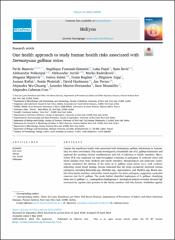One health approach to study human health risks associated with Dermanyssus gallinae mites
| dc.contributor.author | Banović, Pavle | |
| dc.contributor.author | Foucault-Simonin, Angélique | |
| dc.contributor.author | Papić, Luka | |
| dc.contributor.author | Savić, Sara | |
| dc.contributor.author | Potkonjak, Aleksandar | |
| dc.contributor.author | Jurišić, Aleksandar | |
| dc.contributor.author | Radenković, Marko | |
| dc.contributor.author | Mijatović, Dragana | |
| dc.contributor.author | Simin, Verica | |
| dc.contributor.author | Bogdan, Ivana | |
| dc.contributor.author | Zając, Zbigniew | |
| dc.contributor.author | Kulisz, Joanna | |
| dc.contributor.author | Woźniak, Aneta | |
| dc.contributor.author | Hartmann, David | |
| dc.contributor.author | Perner, Jan | |
| dc.contributor.author | Wu-Chuang, Alejandra | |
| dc.contributor.author | Mateos-Hernandez, Lourdes | |
| dc.contributor.author | Moutailler, Sara | |
| dc.contributor.author | Cabezas-Cruz, Alejandro | |
| dc.date.accessioned | 2024-05-31T07:12:39Z | |
| dc.date.available | 2024-05-31T07:12:39Z | |
| dc.date.issued | 2024 | |
| dc.identifier.issn | 2405-8440 | |
| dc.identifier.uri | https://repo.niv.ns.ac.rs/xmlui/handle/123456789/822 | |
| dc.description.abstract | Despite the significant health risks associated with Dermanyssus gallinae infestations in humans, they are often overlooked. This study investigated a household case of D. gallinae infestation and explored the resulting clinical manifestations and risk of infection in family members. Microfluidic PCR was employed for high-throughput screening of pathogens in collected mites and blood samples from both chickens and family members. Morphological and molecular examinations confirmed the identity of the mites as D. gallinae sensu stricto (s.s.), with evidence indicating recent blood feeding. Results indicated that the mites exclusively harbored various pathogens, including Bartonella spp., Ehrlichia spp., Apicomplexa, and Theileria spp. Blood samples from family members and poultry tested negative for these pathogens, suggesting a potential reservoir role for D. gallinae. The study further identified haplotypes of D. gallinae, classifying them into D. gallinae s.s., cosmopolitan haplogroup A. Serological analysis revealed elevated IgE seroreactivity against mite proteins in the family member with bite lesions. Antibodies against Bartonella spp. were detected in this individual, indicating exposure to the pathogen. In summary, this study sheds light on the clinical manifestations, pathogen detection, and genetic characterization of D. gallinae infestations, underscoring the necessity of adopting comprehensive approaches to manage such infestations effectively. | en_US |
| dc.language.iso | en | en_US |
| dc.source | Heliyon | en_US |
| dc.subject | Red mites | en_US |
| dc.subject | Allergy | en_US |
| dc.subject | One health | en_US |
| dc.subject | Pathogens | en_US |
| dc.title | One health approach to study human health risks associated with Dermanyssus gallinae mites | en_US |
| dc.type | Article | en_US |
| dc.identifier.doi | 10.1016/j.heliyon.2024.e30539 | |
| dc.citation.volume | 10 | en_US |
| dc.citation.rank | M22 | en_US |
| dc.type.version | published | en_US |
Files in this item
This item appears in the following Collection(s)
-
Naučni radovi
Radovi objavljeni u naučnim časopisima

